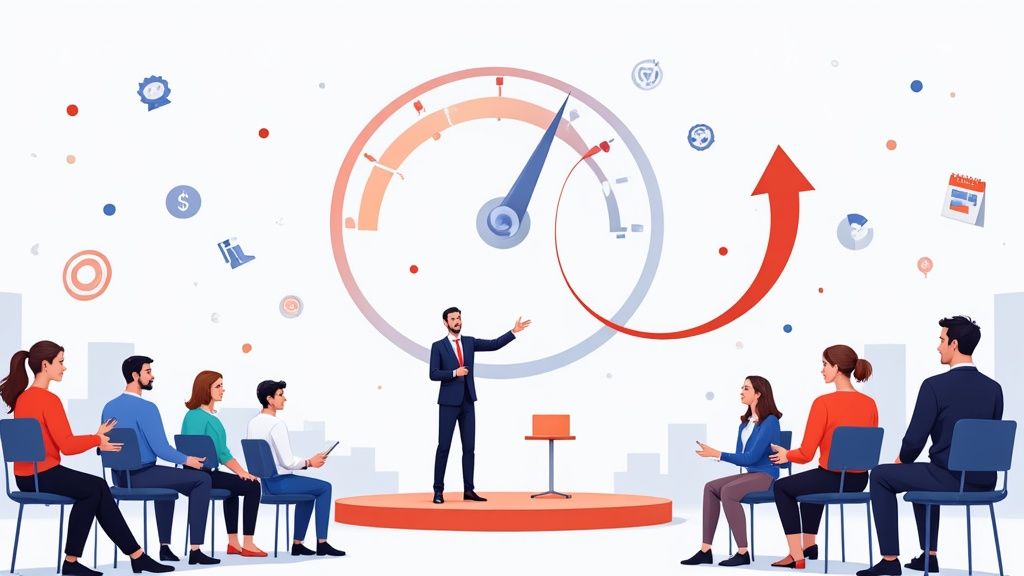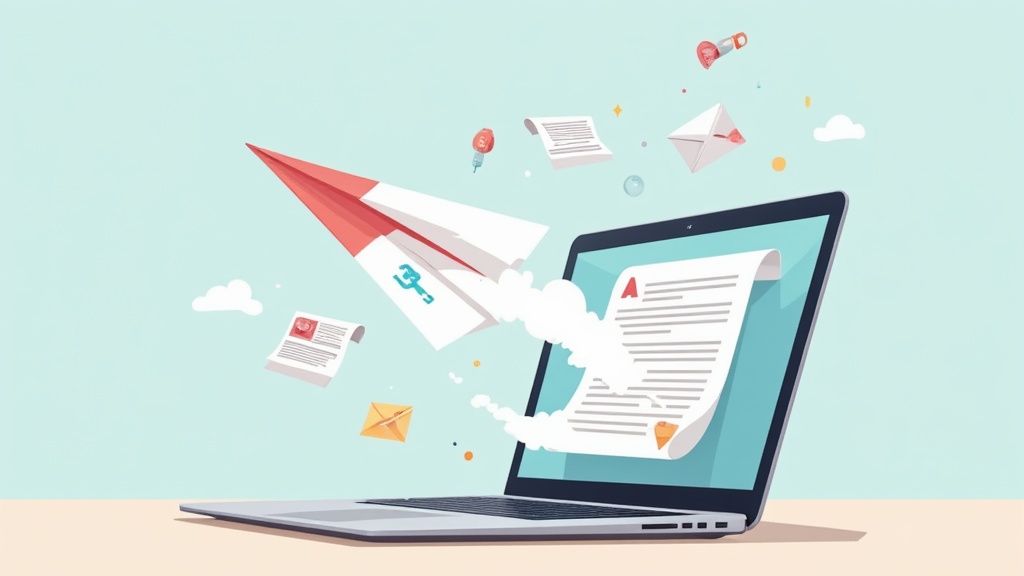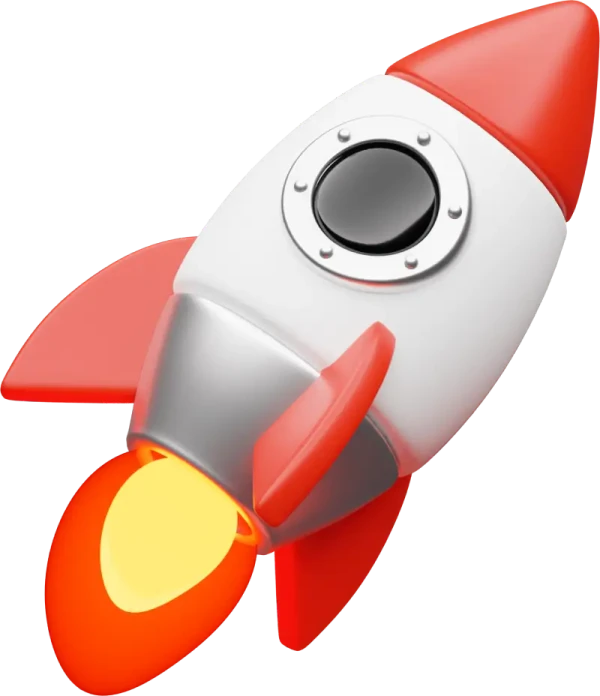An effective event marketing strategy isn’t just a checklist; it's the detailed plan that connects your event to real business goals. It defines who you're talking to, how you'll reach them, and what success looks like long before you book a single speaker. Think of it as the blueprint that turns a simple get-together into a powerhouse for generating leads, boosting sales, and building a loyal following.
Laying the Groundwork for Event Success
Before a single invitation goes out, the real work begins. This is the foundational stage, and it’s all about defining what a "win" actually looks like for your organization. It’s easy to get caught up in vanity metrics like attendee count, but a truly strategic event looks past the headcount. The real objective is to tie your event directly to tangible business outcomes.
This means every choice you make - from the topics on the agenda to the channels you use for promotion - has to be guided by a crystal-clear purpose. Are you trying to fill the sales pipeline with high-quality leads? Or is the main goal to strengthen relationships with your current customers and keep them happy? These are two very different goals, and they demand two completely different playbooks.
Defining Your Event's Core Purpose
An event built for lead generation will likely lean heavily on product demos and introductory content, casting a wide net to attract new prospects. On the other hand, an event focused on customer loyalty would be better served by offering advanced workshops, exclusive networking sessions, and content that deepens the value of your products.
I see so many event marketers fall into the trap of trying to be everything to everyone. An event that tries to acquire new customers, upsell existing ones, and train partners all at once is going to under-deliver on all fronts. Your greatest asset here is focus.
This distinction is absolutely critical because it shapes every decision that follows. The keynote speaker you hire, the registration data you collect, and even how you arrange the room will all shift based on that primary objective. As you plan the physical presence of your event, think about how visuals can make or break the atmosphere. A great place to start is by looking at fresh exhibition display ideas to create a space that perfectly reflects your event's core purpose.
To help you get this right, here’s a simple framework I use to align goals with the right strategy.
Event Goal Alignment Framework
This table breaks down how your primary event goal should ripple through the rest of your strategic planning, from the metrics you track to the content you create.
| Primary Goal | Key Performance Indicator (KPI) | Target Audience Focus | Core Content Theme |
|---|---|---|---|
| Lead Generation | Marketing Qualified Leads (MQLs) | Prospective Customers | Introduction, Problem/Solution, Demos |
| Customer Retention | Churn Rate, Upsell Revenue | Existing Customers | Advanced Use Cases, Best Practices, Community Building |
| Brand Awareness | Social Mentions, Media Impressions | Broad Industry Audience | Thought Leadership, Future Trends, High-Level Insights |
| Partner Enablement | Partner-Sourced Revenue | Channel Partners, Resellers | Co-marketing Strategies, Product Training, Joint Success Stories |
By starting with the "Primary Goal" column, you can see how the other pieces naturally fall into place, ensuring every part of your event is working toward the same objective.
Aligning Goals with Business Growth
Ultimately, your event needs to be a strategic asset, not just another line item on the marketing budget. This is where setting SMART goals (Specific, Measurable, Achievable, Relevant, Time-bound) is non-negotiable. Instead of a fuzzy goal like "increase brand awareness," a powerful SMART goal sounds more like: "Generate 75 marketing-qualified leads (MQLs) from non-customers by the end of Q3."
This kind of clarity is backed up by what we're seeing across the industry. Event marketing is a key player in both acquisition and retention, with a whopping 71% of professionals using events for both. But here's an interesting tidbit: companies that use events to prioritize customer retention are 13% more likely to see their year-over-year growth top 10%. You can dig into more of these event marketing statistics on Swoogo.com.
Doing this strategic work upfront is what ensures your event marketing strategy drives real, measurable growth for the business.
Mastering Multi-Channel Event Promotion
Okay, with your goals locked in, it's time to switch from planning to pure promotion. A killer event marketing strategy isn't about just making noise; it’s about being smart and strategic across different channels to grab the attention of your ideal attendees. This isn't about shouting from every rooftop. It's about showing up where your audience actually spends their time.
Think about it this way: if you're hosting a B2B tech conference, LinkedIn is your playground. It’s the perfect spot to share thought leadership and target specific job titles. But if you’re promoting a food festival for the general public, you'll get way more mileage from visually exciting platforms like Instagram Stories and targeted Facebook ads to build hype.
Choosing Your Promotional Mix
The digital world gives us a massive toolkit for promoting events. It's no surprise that social media is a beast here, with 83% of marketers using it for event promotion. That's often backed up by search marketing (67%) and video (66%). The big players are still Facebook (86%), Instagram (79%), and LinkedIn (65%), and each one has its own unique strengths.
A solid, balanced promotional plan usually involves a mix of these:
- Email Marketing: This is your direct line. You can send hyper-relevant messages to segmented lists of past attendees and interested leads.
- Social Media: Get the organic buzz going. Share consistent updates, spotlight your speakers, and maybe even run a user-generated content campaign.
- Paid Advertising: Use targeted ads on platforms like LinkedIn or Facebook to reach new, highly qualified people who don't know you yet.
- Partner Marketing: Team up with your sponsors, speakers, and industry influencers. They can amplify your message to their own audiences, which is a huge win.
When you combine these, you build momentum on all fronts. It creates a powerful, cohesive story around your event that’s hard to ignore.
The Critical Role of 'Add to Calendar'
Now, let's talk about one of the simplest but most powerful tools in your entire promotional kit: the 'Add to Calendar' button. Its magic lies in bridging that crucial gap between someone signing up and someone actually showing up. Getting the registration is only half the battle. Making sure they don't forget is what really matters.
When an attendee clicks 'Add to Calendar,' they are moving from passive interest to active commitment. They are carving out a dedicated time slot for you in their personal schedule, which dramatically reduces the likelihood of a no-show.
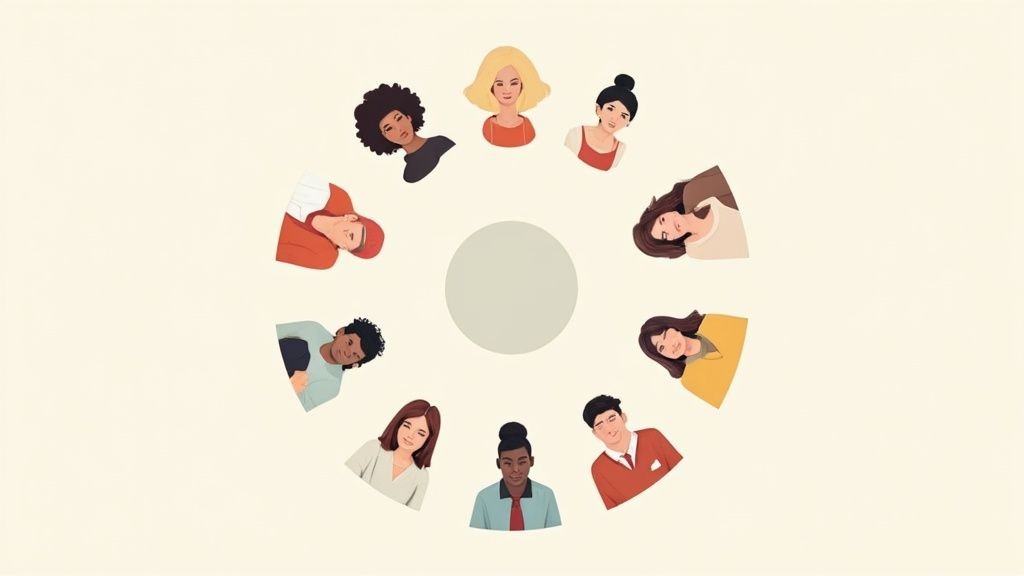
This screenshot shows how Add to Calendar PRO gives you clean, universally compatible buttons that work anywhere. It’s a simple integration that makes it completely effortless for people to pop your event into their Google, Outlook, or Apple Calendar.
By embedding these buttons on your event landing page, in your confirmation emails, and even in social media posts, you’re securing a valuable piece of real estate in your attendee's daily life. It’s a fundamental tactic.
If you want to take this to the next level, check out our guide on event marketing automation to see how calendar events can trigger entire follow-up sequences. This turns a simple reminder into a powerful communication channel, keeping your event top-of-mind from the moment they register until the day it begins.
Crafting an Unforgettable Attendee Journey
A solid event marketing strategy does way more than just get people to sign up. The real difference-maker - what separates a forgettable webinar from a brand-defining moment - is when you intentionally map out the entire attendee journey. It's about creating a seamless, valuable experience from the second they register until long after the event wraps up.
That journey starts the moment they hit "submit." Instead of a single, bland confirmation email, think about a carefully planned communication sequence. This is your first shot at building genuine excitement and delivering value, which goes a long way in making sure they actually show up.
Before the Doors Open
Your pre-event communication is your secret weapon against no-shows. Don’t just spam them with reminders. Send them content that makes them feel like insiders, like they're already part of something special.
A killer pre-event sequence could look something like this:
- A "Know Before You Go" email: This is the practical stuff. Think event links, agenda highlights, and any quick tech checks they should do.
- Exclusive speaker sneak peeks: Drop short video clips or powerful quotes from your keynotes. Give them a taste of the great content to come.
- Networking prompts: Get the conversation started early. Encourage new sign-ups to connect on a dedicated Slack channel or a LinkedIn group.
This kind of proactive communication keeps your event top-of-mind. It flips the script on the waiting period, turning it from a passive waiting game into an active, engaging part of the experience.
The post-registration, pre-event phase is where you win the battle against attrition. Every piece of communication should reinforce the value of attending and make the attendee feel smarter and more prepared for having engaged with it.
During the Event Itself
Engagement doesn't just happen on its own, especially in a virtual or hybrid setting where digital fatigue is very real. You have to actively fight it. Passive viewing is the enemy; you need to spark genuine interaction.
Simple things like live polls can break up the monotony of long sessions and give you instant feedback. I’m also a big fan of moderated Q&A sessions, particularly ones that let attendees upvote questions. It’s a simple way to ensure the most pressing topics get the attention they deserve and makes every attendee feel seen and heard, not just like a name on a viewer list.
After the Final Session
The conversation shouldn't end when the last speaker logs off. The post-event phase is your chance to capitalize on all that momentum you’ve built. This is where your investment really starts to pay dividends by turning attendees into community members, qualified leads, or loyal customers. For a deeper dive, our guide on how to promote events online has a ton of tactics for extending your event's reach.
Your follow-up should never be a one-size-fits-all email blast. Use the data you've gathered to make it personal. For example, with Add to Calendar PRO, you can send targeted follow-ups directly through the calendar event itself. Imagine sending session recordings straight to the calendars of those who attended or scheduling one-on-one demos with hot leads who showed a lot of interest. This approach transforms a single event into a sustained, valuable conversation.
Integrating Technology for a Seamless Experience
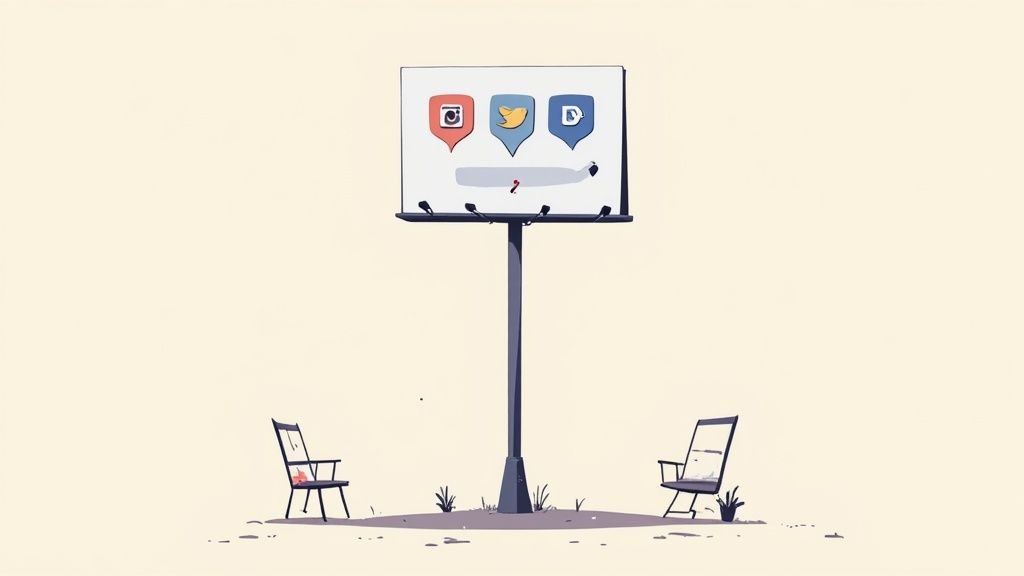
Let’s be honest, in modern event marketing, technology isn't just a helpful add-on anymore. It's the engine. It's the core infrastructure that powers everything from a smooth registration process to engaging post-event follow-ups. Without a solid tech stack, you're just making your own life harder and delivering a clunky experience for your attendees.
The industry gets this. Recent data shows that 24% of event professionals are actively zeroing in on tech innovations. On top of that, a full 50% are exploring how to bring AI into the mix to make their events better. And why wouldn't they? When two-thirds of attendees report feeling more positive about a brand after an engaging event, the ROI on a great experience is crystal clear. You can dig into these stats and more over at Eventgroove.com.
Personalizing the Experience with Tech
So, where does tech make the biggest impact? Personalization at scale. I'm not just talking about using a [First Name] mail merge in an email blast. That's table stakes.
Today's AI-driven platforms can do so much more. Imagine a system that automatically suggests specific breakout sessions or networking opportunities based on an attendee's job title, industry, or even the topics they engaged with on your event website. That’s when things get interesting.
This level of detail makes your attendees feel seen and understood. It transforms your event from a generic broadcast into a curated, individual journey, which is a powerful way to build brand affinity.
Beyond Reminders with Calendar Tech
This is exactly where tools like Add to Calendar PRO really come into their own, elevating calendar tech from a simple reminder tool to a strategic asset. A truly advanced event marketing strategy uses calendar functionality to create unique, segmented experiences. You’re not just sending a single event file to everyone. You’re delivering tailored itineraries.
Think about the possibilities. You could create completely distinct calendar events for different groups:
- VIP Attendees: Their calendar event includes exclusive access to a pre-event reception, complete with the location and a link to the VIP-only section of your app.
- Speakers: They get a schedule that blocks out their specific tech check, green room time, and the session they're leading.
- General Admission: This group receives the main event schedule, highlighting all the keynotes and public breakout sessions.
This targeted approach ensures every single person gets a schedule that's directly relevant to them. The best part? You can dynamically update these calendar events to reflect last-minute room changes or schedule adjustments. It creates a single source of truth that lives right on their personal device.
A generic calendar reminder is helpful. A personalized calendar event that details a VIP-only networking session with the exact location and a direct link to the attendee-exclusive app is strategic. It’s a small detail that delivers an exceptional experience.
By weaving technology into your strategy this thoughtfully, you streamline your own logistics while making every attendee feel like the star of the show. That level of precision is what separates a good event from an unforgettable one.
Measuring Your Event's True Impact and ROI
So, the event is over. The last attendee has left, the booths are packed up. Now for the big question: Was it a home run?
An effective event marketing strategy doesn't just stop when the lights go out. The final, crucial piece is proving its value. To really do that, we need to look past the easy-to-find numbers like total attendance or social media likes. It’s time to focus on what truly matters to the business: a tangible return on investment (ROI).
It all comes back to the SMART goals you set way back in the planning phase. Was your main goal to generate a flood of new leads? Or maybe it was about boosting customer retention and preventing churn? Whatever the objective, the key performance indicators (KPIs) you track now must tie directly back to those original business outcomes.
Moving Beyond Vanity Metrics
Building a solid measurement framework means shifting from high-level "awareness" metrics to concrete business impact. It’s about having the right answers when leadership and the finance team come knocking. Trust me, vague statements like "we had great engagement" just won't cut it. You need to tell a story backed by hard data.
Instead of just reporting on attendance numbers, let’s dig into the KPIs that really move the needle:
- Cost Per Qualified Lead: This one is simple but powerful. Just divide your total event cost by the number of marketing-qualified or sales-qualified leads you generated.
- Pipeline Influenced: Fire up your CRM and start tracking which new opportunities were created or sped up because of interactions at your event.
- Customer Lifetime Value (CLV): For events focused on retention, see if attendees show higher upsell rates or lower churn in the months that follow.
- Brand Sentiment Shifts: Use social listening tools and survey responses to analyze how perceptions of your brand changed from before to after the event.
This chart gives you a sense of a common budget breakdown, showing where marketing dollars often go to hit these kinds of goals.
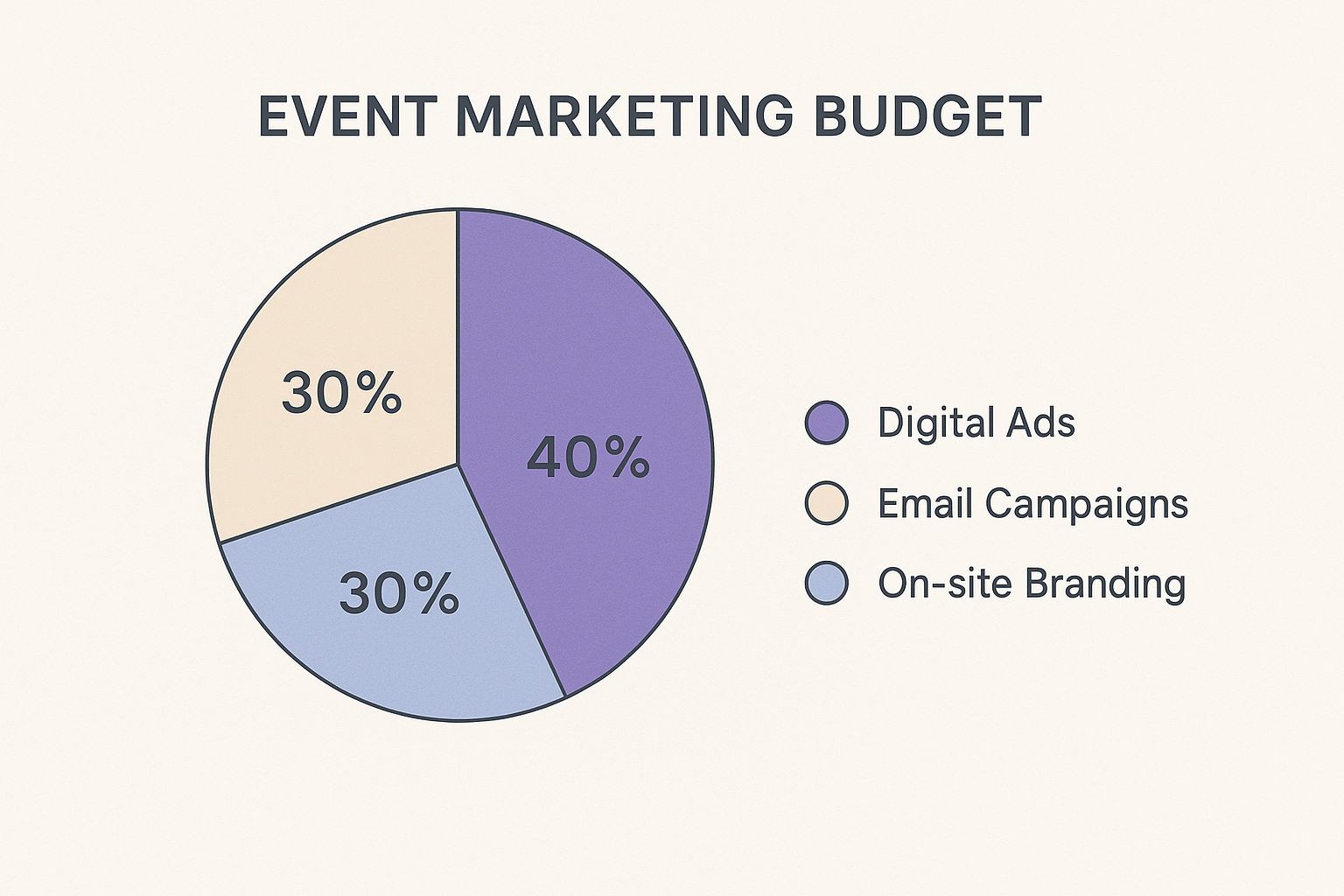
As you can see, this visualizes a balanced approach. Digital promotion and direct email campaigns carry significant weight, which makes sense given how critical they are for driving registrations and keeping people engaged.
Collecting the Right Data
To track these more advanced metrics, you need a solid system for collecting and analyzing data across the entire event lifecycle. This isn't about looking at one source; it's about piecing together information from multiple touchpoints to get the full picture.
Your data collection strategy should pull from a few key places:
- Registration Forms: This is your first chance to capture valuable firmographic and demographic data.
- CRM Integrations: Tag every attendee and track their complete journey, from a curious prospect to a loyal customer.
- Post-Event Surveys: Go straight to the source and gather direct feedback on satisfaction, what they learned, and what they plan to do next.
- Social Media Analytics: Keep an eye on mentions, sentiment, and overall reach to gauge the online buzz.
A crucial, and often overlooked, metric is attendee intent. While post-event surveys are great for measuring satisfaction, things like calendar subscription rates can signal commitment before the event even starts. A high subscription rate - a unique data point you get from a tool like Add to Calendar PRO - suggests you've got a highly motivated audience on your hands.
To truly understand your event's performance, you need to track the right metrics at every stage. This table breaks down some of the most essential KPIs to monitor.
Essential Event Marketing Metrics
| Metric Category | Example KPI | What It Measures | Tool for Tracking |
|---|---|---|---|
| Pre-Event | Calendar Subscription Rate | The percentage of registrants who add the event to their calendar, signaling high intent. | Add to Calendar PRO |
| During-Event | Session Attendance | Which specific sessions or booths were most popular, indicating content relevance. | Event Platform Analytics |
| Post-Event | Net Promoter Score (NPS) | Attendee loyalty and satisfaction, and their likelihood to recommend your event to others. | SurveyMonkey, Typeform |
| Business Impact | Pipeline Influenced | The value of sales opportunities created or accelerated by event interactions. | Salesforce, HubSpot |
By combining these data points, you can weave together a comprehensive and compelling story of your event's success.
If you're just starting to build out your first real measurement framework, our guide to creating an event marketing plan offers some great templates and deeper insights. Presenting a clear, data-supported narrative doesn't just justify your budget - it builds incredible momentum for all your future event initiatives.
Common Questions About Event Marketing Strategy
Even with the best playbook in hand, questions always pop up when you're in the trenches building an event marketing strategy. We get it. Here are some of the most common questions we hear from marketers on the front lines, covering everything from classic mistakes to proving an event's real value.
What Is the Most Common Mistake in Event Marketing?
The single biggest pitfall is getting completely lost in the weeds of logistics and promotion before you've even defined what success looks like. It’s so easy to get swept up in the excitement of booking a venue or designing slick social media posts.
But without a North Star - a clear, measurable business objective - your efforts are just spinning wheels.
If you don't know what you're aiming for, how can you possibly know if you hit it? Think specific goals, like generating 100 qualified leads from the event or boosting customer retention by 5%. Every single decision, from the content you create to the tech you use, needs to flow directly from those primary goals.
How Far in Advance Should I Promote an Event?
There’s no magic number here; the right promotional runway really depends on the scale of your event and who you're trying to reach. But after years of seeing what works, we've got some solid guidelines.
Here’s a good starting point:
- Large Conferences or Trade Shows: Start your engines 4-6 months out. This gives you plenty of time to roll out a multi-phase campaign, from early bird pricing and speaker announcements to full agenda reveals.
- Smaller Workshops or Webinars: A shorter timeline of 4-6 weeks is usually more than enough. For these, the goal is to build and maintain momentum without burning out your audience before the event even starts.
No matter the timeline, the key is to structure your promotion in waves. Kick things off with a simple "save the date," then build anticipation with content previews and speaker spotlights. In the final two weeks, ramp up the urgency to snag all those last-minute registrations.
How Can I Boost Engagement at a Virtual Event?
To keep a virtual audience glued to their screens, you have to make interaction easy, rewarding, and part of the main event - not an afterthought. Passive content is the enemy of engagement.
Don't just talk at them; build participation directly into the fabric of your event.
Use tools like live polls and Q&A sessions with upvoting features to give everyone a voice. We've seen breakout rooms work wonders for creating smaller, more intimate discussions that feel a lot like real-world networking. You can also add a layer of fun with gamification, like awarding points for visiting virtual sponsor booths or asking great questions.
For hybrid events, having a dedicated community manager for the virtual audience is a game-changer. Their entire job is to bridge the physical and digital divide, making sure online attendees feel just as seen and valued as the people in the room.
What Makes an 'Add to Calendar' Button So Important?
Honestly, it's because an 'Add to Calendar' button turns fuzzy interest into a firm commitment. When someone registers for your event, they're interested. But when they physically add it to their personal calendar, they are blocking out their time and committing to show up.
That one simple click dramatically slashes your no-show rate. It places an automated reminder right in the one place they trust and check dozens of times a day.
But it’s more than just a reminder. With the right tools, that calendar entry becomes a powerful, dynamic communication channel. You can send updates, links to session recordings, and post-event follow-ups directly to the attendee's calendar. It keeps the conversation going long after the event ends.
Ready to turn attendee interest into commitment? Add to Calendar PRO makes it easy to add beautiful, reliable calendar buttons to your website, emails, and landing pages, helping you reduce no-shows and keep your audience engaged. Explore the features.

